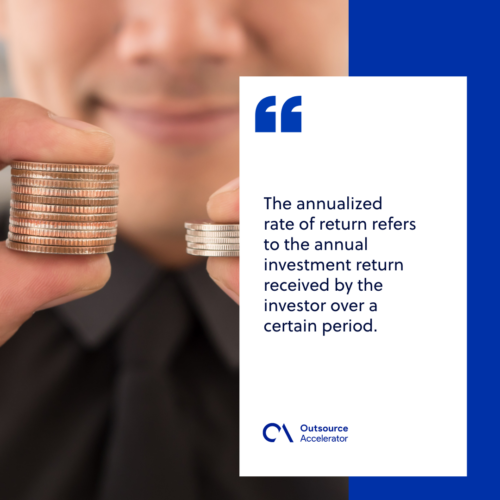Annualized rate of return
Definition
What is an annualized rate of return?
The annualized rate of return refers to the annual investment return received by the investor over a certain period.
The said period can be less than a year but is still calculated as such.
Portfolio returns may not be annualized as dictated by The Global Investment Performance Standards.
A percentage of higher than a 6% rate is considered to be a reasonable rate of return. However, it depends on the stock market if the investment has a valuable interest rate or volatile returns.

When to use the annualized rate of return
Naturally, investors would want to know how much earning they gain from their investments. As they calculate their earnings, the rate of return comes into the picture.
Whatever percentage of asset return you can get, it is still quite difficult to understand which asset consists of better returns until you measure and analyze which asset has delivered the higher rate of returns.
Over the years, the annual rate of return might decrease unless there is a market analysis done simultaneously in sales and purchase of stocks.
How to calculate the annualized rate of return
Calculating the annualized rate of return on a time-weighted basis allows investors to measure asset returns over any period. Below is the formula:
Annualized rate of return = ending value 1N -1
beginning value
In the above formula, the ending value or the investment value at the end of a period is divided by the value at the beginning of the period. N represents the number of years the investment is held. 1/N can also be replaced with 365/N where N, in this case, represents the number of days.
The annual rate of return allows investors to measure the losses and gains and compare various types of investment performance within the same time frame to be more profitable.
Example of an annual rate of return
ABC company has two investments with the same beginning value of $50,000 and are compensated in different periods. The first investment has returned $75,000 in ending value in three years, and the other has returned $100,000 in ending value in five years.
The total returns for the holding periods were 50% and 100% for investments 1 and 2, respectively.
Below is the given data for calculating the annualized rate of return.
| Particulars | Investment 1 | Investment 2 |
| Beginning investment value | $50,000 | $50,000 |
| Ending investment value | $75,000 | $100,000 |
| Time period (n) | 3 | 5 |
| Annual rate of return | 14.47% | 14.87% |
Annualized rate of return vs average rate of return vs total rate of return
In a nutshell, the annual rate of return, the average rate of return, and the total rate of return share the same goal, which is to determine the rate of return essential for investors to measure which projects of your business lost or gained over time.
Calculating average rate of return
Average rate of return (%) = Average annual profit
────────────── x100
Initial cost of investment
The average rate of return deals with the average net income or net cash flows (sometimes referred to as net profits) that came from the percentage of the initial capital of investment.
Like the annualized rate of return, it can also be helpful to compare different types of investment options. Getting the average rate of return is calculated by getting the expected net earnings and dividing it by the number of years of investment it’s expected to last.
It is a common method to measure and evaluate investment projects by comparing the annual rate of profits alongside the payback period, which compares project duration and cash flow timings.
Calculating total rate of return
Total return = current value- cost basis + distributions / Cost basis x 100
The total rate of return, on the other hand, refers to the actual rate of return gained from the investments. It is also generally expressed as a percentage that allows for the comparison of the performance of different assets or investments.
To get the total rate of return, a simple formula is used. This is done by subtracting the current value of the investment from the cost basis of the assets and then adding the value of the profit earnings and multiplying it by 100 to get the percentage figure.







 Independent
Independent




